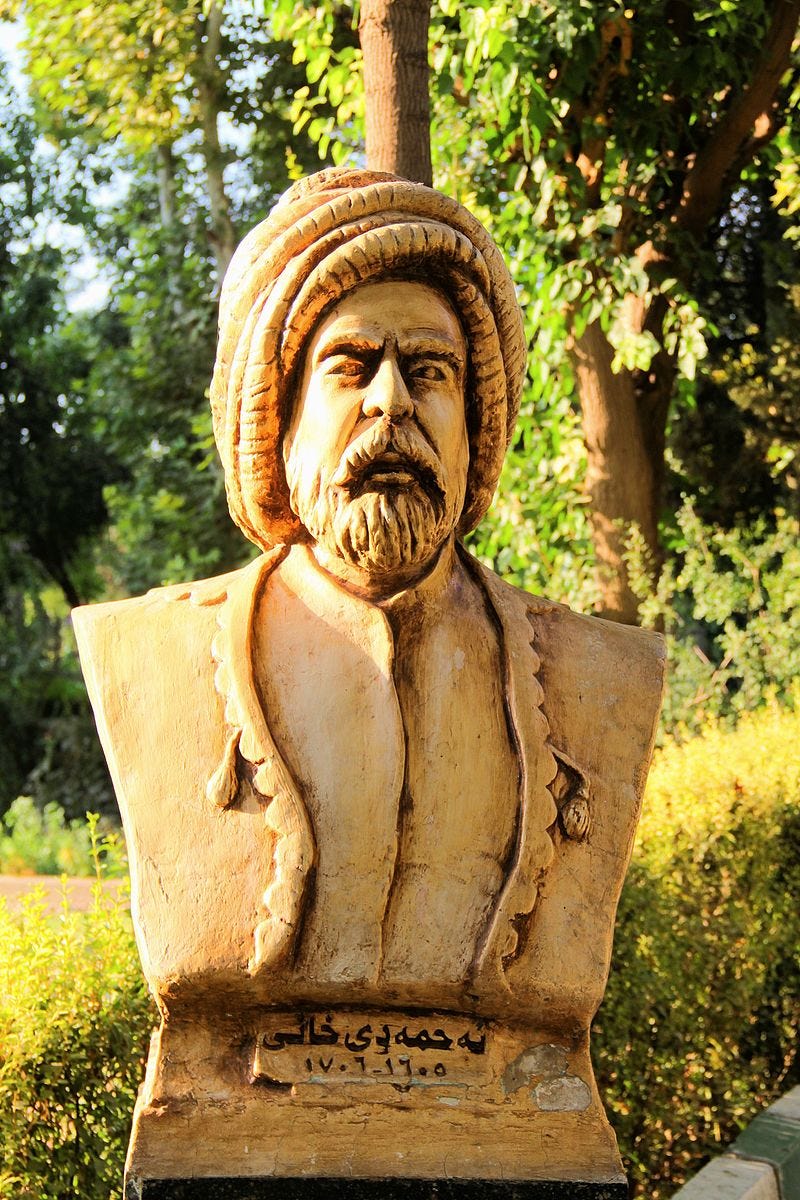The History and Current Status of the Kurdish Language
Part 2: Ahmed Xanî's Contribution to Kurdish Literature
This is Part 2 of a series of articles on the Kurdish language. Click here to read part 1!
Throughout the Kurds’ history, their land has consistently been at the center of conflicts between various empires. With different empires competing for ownership of their lands, this led to shifting alliances among Kurds with these political powers, resulting in the dominance and spread of other cultures into Kurdistan. This domination ultimately led to the limited use of Kurdish among the Kurds, as other languages became more relevant for use with the different cultures they’d encounter, in contrast to Kurdish. The issue of assimilation was particularly poignant during the Ottoman Empire in the 15th century, where languages such as Turkish and Persian were more dominant as lingua franca for communicating with everyone.
Due to the widespread nature of languages like Turkish and Persian, many Kurds wrote in these languages rather than in Kurdish. Scholars such as Sharaf Khan and Idris Bitlisi frequently used Persian in their written works and communication with others. Before the 15th century, it wasn’t unusual for Kurdish poets to express themselves in Arabic. Kurdish writers utilized these languages due to the ease of communication they provided, allowing their works to draw in larger audiences and garner more acclaim for their writing. As a result, they often neglected using Kurdish in their interactions with others, with the language gathering dust as other languages took hold in the daily lives of these scholars.
Ahmed Xanî’s work would depart from this trend of abandoning Kurdish in literary use. A Kurdish poet and Muslim scholar, in 1692, Ahmed Xanî wrote the love story Mem û Zin in Kurdish. This story became one of the first literary works in Kurdish, significantly contributing to the formation of Kurdish consciousness that would intensify in the 20th century.
It was not only Xanî’s choice to write in Kurdish that made it a crucial building block for Kurdish identity. Some of the content in Mem û Zin would ultimately form the backbone of this story’s role in shaping Kurdish identity. While the poem is ultimately about a couple who fall in love despite being from different tribes, the introduction in the poem has a few passages that sound very similar to Kurdish national aspirations today, with one passage in the introduction stating:
Ger dê hebuwa me îttîfaqek
vêk ra bikira me înqiyadek
Rom û `Ereb û `Ecem temamî
hem'yan ji me ra dikir xulamî
tekmîl-i dikir me dîn û dewlet
tehsîl-i dikir me `îlm û hîkmet
“If only there were unity among us, and we would obey one another, then all of the Ottomans and Arabs and Iranians would become our servants, we would reach perfection in religion and politics, and we would become productive in knowledge and wisdom.”
While the language Ahmed Xanî uses here resembles modern-day Kurdish patriotism, it is essential to consider Xanî’s historical context to understand what he likely meant by saying these words. Considering the political nature of the Ottoman Empire, Ahmed Xanî would not have been expressing a desire for the Kurds to have a nation-state similar to those of countries like Turkey or Iran today. In his lifetime, state structures based their existence upon religious identity and loyalty to a ruling dynasty, such as the Ottoman Empire and the Safavids, where Turkish was common in both empires but was not the basis of state identity as much as it was on Islam and their respective ruling families. Thus, Ahmed Xanî may have lamented the Kurds’ lack of influence not because they lacked a modern nation-state, but rather because there was no foreseeable opportunity for the Kurds to rule as a dynasty over an empire similar to those of the Ottomans or the Safavids, due to internal divisions among themselves.
Even if his vision for Kurdish prosperity looked different from the desires of many Kurds today for a modern nation-state of their own, Ahmed Xanî’s passion for his culture and language still thrives in his writing. While his poem Mem û Zin is primarily a form of Sufi poetry, using a love story to express religious and mystical ideas, Xanî’s introduction and his choice of writing the love story in Kurdish put a spotlight on his passion for the Kurdish language and culture. The fact that he wrote in Kurdish, rather than other languages like Farsi, which would have made him more famous, highlights his commitment to making Kurdish a legitimate literary language. He expresses this ambition in further writing, stating, “So that people won’t say that the Kurds have no knowledge and have no history; that all sorts of peoples have their books and only the Kurds are negligible.”
This ethnic passion for his homeland made Ahmad Xanî an icon in Kurdish national history. Due to his enthusiasm for his heritage, generations of Kurds in the future began to view his work, Mem û Zin, as a story showcasing the Kurdish struggle for autonomy. While the story’s purpose may not have been to focus on Kurdish aspirations, Ahmad Xanî’s literary contributions to the Kurdish language through this work gave future Kurds an image of such ambitions. Were it not for Ahmad Xanî’s work, alongside the work of other Kurdish authors at the time, his worst fears of the Kurds never achieving literary status may never have come true, and Kurdish may have faded with time. This newfound literary status paved the way for other developments in the Kurdish language, particularly between the 19th and 20th centuries, coinciding with the colonial politics surrounding the end of the Ottoman Empire and the two World Wars.
Stay tuned next week for part 3 of this series!







To Caleb and Federica, this was an awesome article! I loved learning more about Ahmed Xanî and his poem: Mem Û Zin, and how that had an impact on Kurdish national history! thanks for sharing this! (gelek spas!)
❤️ ☀️💚